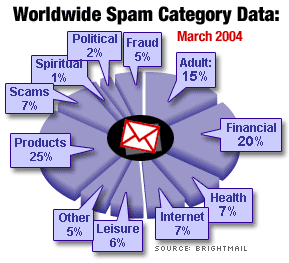
The Bull is back. I know this for certain. My spam tells me so.
This one, for example.
*** URGENT INVESTOR TRADING ALERT *** (XXXX) is our PLAY OF THE MONTH stock pick.
And this ....
**Our Picks Are On Fire!** ... Rising oil prices at record highs with no signs of dropping have set the stage for a major windfall in an emerging developer of high-profit based oil and gas reserves. (XXXX shares) are set to explode based on expanded production through strategic partnerships for producing fields in 4 major oil-producing states.
You're probably getting similar come-ons. And you should recognize them as come-ons ... stupid, fraudulent, invitations to throw away your money.
You remember the pump and dump, right? That's where a certain someone buys stock in a company, then goes to message boards, chat rooms, and spam e-mail lists to talk other people into buying it. Their sudden surge in buy orders sends the stock price up, allowing the certain someone to unload his stock at a profit.
Get it? He pumped up the value of the stock, then dumped it.
Usually it is a penny stock with little in the way of research or analyst coverage. With such low values and limited shares, even small buying waves can lead to big jumps. The companies often don't even know it's happening (that's why I left their names out of the e-mails cited above).
This scam was common in the late 1990s, when Internet stock trading came of age. A few people got convicted for it. One 15-year old made $273,000 by running such a scam (he had to give it back). Wall Street had its own bigger time version of it, issuing research that over-hyped some stocks, even when the stock was being trashed in house.
The numbers back up my unscientific observations that market scamming is on the rise.

According to Brightmail, a San Francisco outfit that monitors and filters e-mail for clients around the world, financial based spam has been on the rise and as of March accounted for one out of every five e-mails.
Straight out scam and fraud e-mails (like the Nigerian guy asking to use your account to park a few million dollars) have fallen. They made up about 12 percent of e-mails, down from 15 percent in February.
So why am I taking the resurgence of such e-mails as a positive sign?
YOUR E-MAIL ALERTS
|
Follow the news that matters to you. Create your own alert to be notified on topics you're interested in.
Or, visit Popular Alerts for suggestions.
|
|
|
 |
Because it means that scammers and schemers think enough gullible investors are coming to the market to make it worth their while to run the old pump and dump. The market, in other words, must be really coming back to attract the charlatans.
Sure, it's a cynical way of looking at market improvement, but hey, I gotta be me.
Now, does this mean we're at the top? I don't think so. I'm still getting more Viagra/Cialis and pharma spam than financial spam. But the finance spam is starting to build.
When the ratio gets to be even, that's when I'll call the top.

Allen Wastler is Managing Editor of CNN/Money and a commentator on CNNfn.
|

